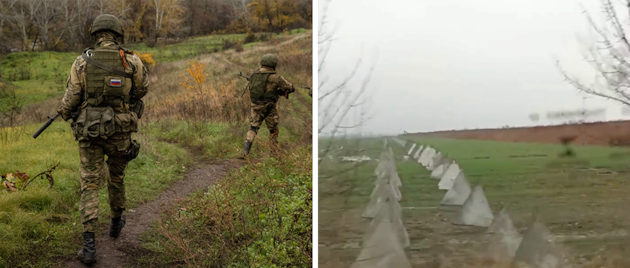Russia has set up a network of tank traps and trenches along several fronts in Ukraine. What looks like WWII warfare could bring important benefits to the Russians. In the end, however, Putin’s army threatens to fail on its own.
“Dragon’s teeth” and tank traps are supposed to deter the Ukrainians from further counter-offensives in the war with Russia. As the New York Times reports, Russia is building trenches and tank traps in record time along the front lines in the east around Popasna near Bakhmut and in the south between Crimea and Cherson.
The Russian army is said to have dug defensive positions into Ukrainian soil in rows stretching for kilometers. Pointed pyramids – also called “dragon teeth” – and deep trenches are designed to stop Ukrainian tanks advancing towards annexed territories. In trenches with small shooting ranges, Russian soldiers are supposed to push back the Ukrainians.
About twelve kilometers from the front in Bakhmut, the Russian army pounded out a good dozen defensive positions in just six days. Data analyzed by the newspaper shows how more than a hundred Russian defense positions have been deployed in the region in just 11 days since November.
As Philip Wasielewski of the Foreign Policy Research Institute told The New York Times, the defensive positions can serve as a safe haven for Russian soldiers. But: “These are just holes in the ground unless held down by motivated, disciplined soldiers supported by artillery, mobile reserves and logistics.
According to the American Institute for War Studies (ISW), Russia is said to have already started building trenches and positions around Cherson in southern Ukraine at the end of October. After retreating to the southern side of the Dnipro River, it could serve as a natural barrier against the construction of new defensive positions. According to the ISW, this could indicate that the Russians fear a Ukrainian counter-offensive across the Dnipro.
According to the New York Times, many of the Russian positions in the south are used to protect supply lines from the Kherson region to Crimea from attack. For example, several defensive positions have been erected at short intervals along highway 14 in the direction of Zaporizhia – about 10 kilometers from the river bank.
Advantages of fixed positions:
Disadvantages of fixed positions:
The success of a new wall of defensive positions ultimately depends on the strength of the Russian army. Although Russia has mobilized several hundred thousand reservists, they do not have the necessary combat experience, let alone the equipment, to secure the positions in the long term. If Russia now uses young recruits for front defense, as assumed by the ISW, in order to use experienced forces for other missions, this could take revenge in the event of Ukrainian counterattacks.
